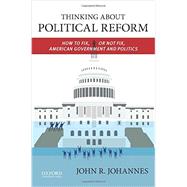Thinking About Political Reform: How to Fix, or Not Fix, American Government and Politics offers the most comprehensive and highly accessible analysis of reform proposals available. It treats both the causes and consequences of structural, procedural, and behavioral problems, assessing a wide variety of reform proposals from the perspectives of political science, economics, law, journalism, and politics.
Author John R. Johannes places reform proposals in the context of seven key standards for sound democratic government. He applies those standards and an up-to-date review of the scholarly literature and current events to the reform agenda, suggesting several approaches to evaluate, for example, the tensions between Congress and the presidency, election systems, or political parties. Johannes reminds students that reforms in one area are bound to have consequences in others, thereby advocating a system-wide approach to reform and a wariness of ad hoc reforms prompted by political events.








